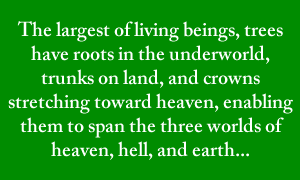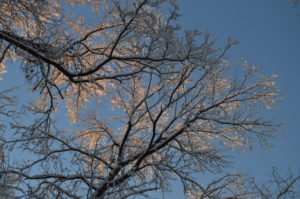The Hidden Life of Trees

As I write, glancing—a little too often to be very productive—out of my office windows on this bitterly cold January afternoon, the winter sun is just beginning to sink. In another half hour, it will set the bare canopies of my front yard’s great oaks into flames of orange, pink, and deep plum.
It’s a trick, of course––a bit of nature’s magic, a show that will repeat itself on clear evenings for a few more weeks before days begin to lengthen and the sun angles itself toward spring. At our latitude in Charlotte, foliage won’t be far behind. Winter’s wizened, naked crones will don green robes and become girls again. But, if I can be still like these stately arboreal sisters, resist mind’s rush toward the longer, warmer, busier days of spring and instead sync myself to winter’s slower rhythms, I can participate in this spectacular mystery play.
Relationship with and participation in nature, particularly in the life of forest trees, is precisely what Peter Wohlleben encourages in his international bestseller The Hidden Life of Trees. In this genre-blending work, Wohlleben, a forester turned ecologist, provides a naturalist’s lessons about the ecology of the forest with the voice of a gifted storyteller, convincing readers that forest trees are indeed social beings that share resources with one another, nurse their “children” with sugar and other nutrients, and have an ability to learn from experience. Above all, Wohlleben champions looking at the environment through the much longer lens of forest trees, those giant beings I like to think of as our first ancestors.
 Okay, perhaps I’m stretching the metaphor a bit by referring to them as ancestors, but I’m not the first to project human characteristics upon trees. It’s easy to see why. Their vertical structures bear resemblance to human bodies—long torsos that branch into elegant limbs, then extend further into slender, finger-like branches; crowns that, when fully leafed, resemble full heads of hair; knots and scars that mimic facial features. And, though they don’t have the human capacity to pick up their roots and walk, it sometimes seems they might.
Okay, perhaps I’m stretching the metaphor a bit by referring to them as ancestors, but I’m not the first to project human characteristics upon trees. It’s easy to see why. Their vertical structures bear resemblance to human bodies—long torsos that branch into elegant limbs, then extend further into slender, finger-like branches; crowns that, when fully leafed, resemble full heads of hair; knots and scars that mimic facial features. And, though they don’t have the human capacity to pick up their roots and walk, it sometimes seems they might.
Writers and artists from Virgil to Tolkien have told such tales, endowing forest trees with human feeling and mobility, while honoring their role as keepers of ancient wisdom and sacred mysteries. The largest of living beings, trees have roots in the underworld, trunks on land, and crowns stretching toward heaven, enabling them to span the three worlds of heaven, hell, and earth and making them central figures in mythologies throughout the world. Virgil even asserted that the first humans were born of a mighty oak.
Indeed, trees have captured human imagination since our beginnings, which by the way is much more recent than theirs. Trees began to populate the earth 385 million years ago. Human beings didn’t begin to evolve until around two million years ago, and when we did, it was with dreams of trees.
Our hominid forbears lived most of their lives in the relative safety of the tree canopy, dropping to earth for limited forays until climate change caused vast numbers of trees to die off and forced these early ancestors to adapt to life on the ground. Still, we haven’t lost our fascination with the great beings in whose arms we slept, ate, and nursed our young. We wonder what they’ve witnessed in their much longer lives (the oldest tree on record is 9,550 years old), how the world has changed, and the ways in which it hasn’t.
We also realize that, despite living in an electronic age, we haven’t yet lost our dependence on these creatures whose bodies served as our first nurseries. Granted, as the daughter of a carpenter, I’m a particular fan of hardwood floors and knotted pine furniture, but as I look around, I see that I’ve never really left the forest nursery. I live in a wood-frame house, sleep in a four-poster pine bed, pull my clothes from walnut dressers and paperback books from oak library shelves, toss tonight’s salad in a bowl made from teak. And who among Americans today is much different? What would we do without the trees?
Well, for one thing, we’d have a pretty hard time breathing. Remember, trees breathe in carbon dioxide and breathe out the oxygen—a good enough reason to contemplate their importance to human life. But because they are so essential to our health and well-being, trees have long held a primary role in human culture. After all, without trees there would be no recorded literature. In that sense, my vocation as a writer is as much tied to the trees as my father’s.
This year, Charlotte Lit will celebrate tree culture in our “city of trees.” Planning is underway, so stay tuned for a series of events that will include author readings, lectures on Charlotte’s tree canopy, a paper-making workshop. Meanwhile, add Wohlleben’s book to your winter reading list. Maybe even read it under a tree-shaded table in the park. Your blood pressure will likely drop and you’ll be filled with a phytoncide-fueled sense of well-being. Yep, I learned that in The Hidden Life of Trees.
